8 Native Plants for Seattle, WA
BY LASHONDA TUCKER | APRIL 17TH, 2023 | LANDSCAPING, SEATTLE, WASHINGTONSome may say Seattle has two seasons: wet and dry. You can enjoy the multiple walking trails at Washington Park Arboretum, or, when the relentless drizzles kick in, duck inside and explore the retail shops at Pike Place Market. But unlike you, your yard cannot duck inside to avoid the humidity, rain, or summer drought-like conditions that define Seattle. You need plants that can handle these conditions. That’s why we’ve compiled a list of the best native plants for Seattle.
You’ll want a yard full of plants that are adapted to the Pacific Northwest climate. In this article, we’ll explore a variety of plant types native to Seattle.
- Pacific Bleeding Heart
- Tall Oregon Grape
- Vine Maple
- Wild Ginger
- Salal
- Common Camas
- Evergreen Huckleberry
- Red Flowering Currant
- How to Choose Native Plants for Your Seattle Landscape
- FAQ About Native Seattle Plants
- Where to Find Native Plants in Seattle
1. Pacific Bleeding Heart (Dicentra formosa)
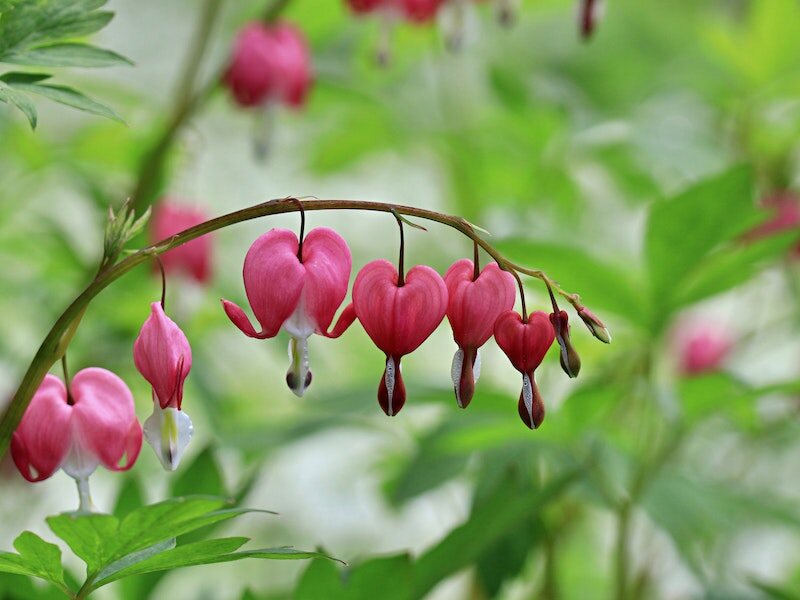
Photo Credit: Pexels
Pacific bleeding heart’s trademark is its delicate-looking, heart-shaped pink or white flowers. It’s also called fern-leaf bleeding heart because of its fern-like foliage.
If your yard is visited by local forest dwellers, these hearts are a good idea; they’re rabbit and deer resistant. Pacific bleeding hearts are a great choice for borders and cottage or shade gardens. But be careful if you have skin allergies, the leaves can cause irritation.
With that caveat in mind, cover up with gloves and other protective gear, plant these bleeding hearts, and watch as they attract hummingbirds, butterflies, and other birds.
Plant type: Flower
Hardiness zones: 3 to 9
Sun: Full sun to partial shade. Thrives in partial shade. Tolerates full shade, but less flowers will bloom.
Soil: Moist, well-drained, humus-rich soil
Duration: Perennial
Fragrance: None
Bloom time: Late spring to early summer
Water needs: Low to medium
Mature height: 1 to 2 feet
Potential hazards: Toxic to humans and animals. Causes sickness when ingested and is a possible skin irritant.
Maintenance: Low
2. Tall Oregon Grape (Mahonia aquifolium)
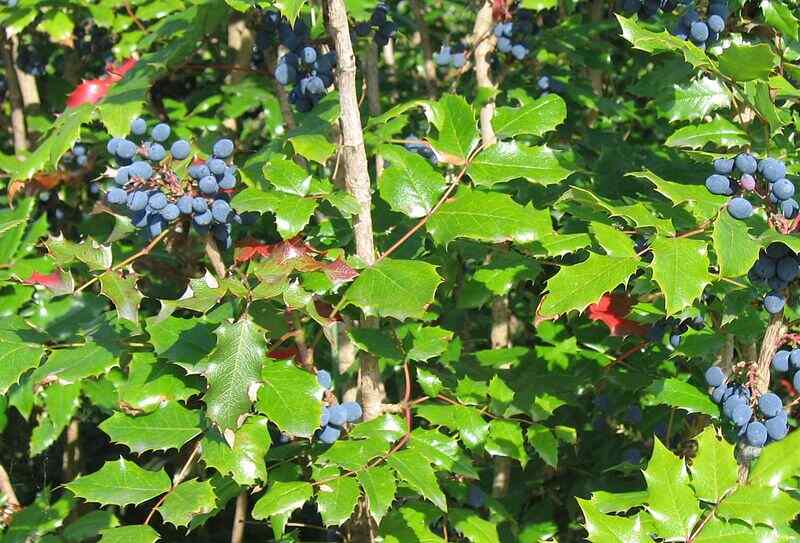
Photo Credit: Meggar / Wikimedia Commons / CC BY-SA 3.0
If you have pets or small children, the toxic properties of the pacific bleeding heart may cause concern. No worries. The tall Oregon grape is not only deer-resistant and low maintenance like the bleeding heart, it’s non-toxic and has medicinal uses, too. It treats skin diseases and is known for its antibacterial and anti-inflammatory characteristics.
The tall Oregon grape, also called the Oregon grape holly, adds color to any home. Its bright yellow flowers greet you in the spring and its purplish-blue berries beckon you in the summer. Pollinators feast on the flowers, while wildlife and birds come around for a taste of the edible berries that look like small grapes. Plant the tall Oregon grape in groups in woodland or shade gardens.
Plant type: Shrub
Hardiness zones: 5 to 8
Sun: Partial shade to full shade
Soil: Loam, acidic, well-drained
Duration: Perennial
Fragrance: Honey
Bloom time: Spring
Water needs: Medium
Mature height: 6 to 8 feet
Maintenance: Low
3. Vine Maple (Acer circinatum)
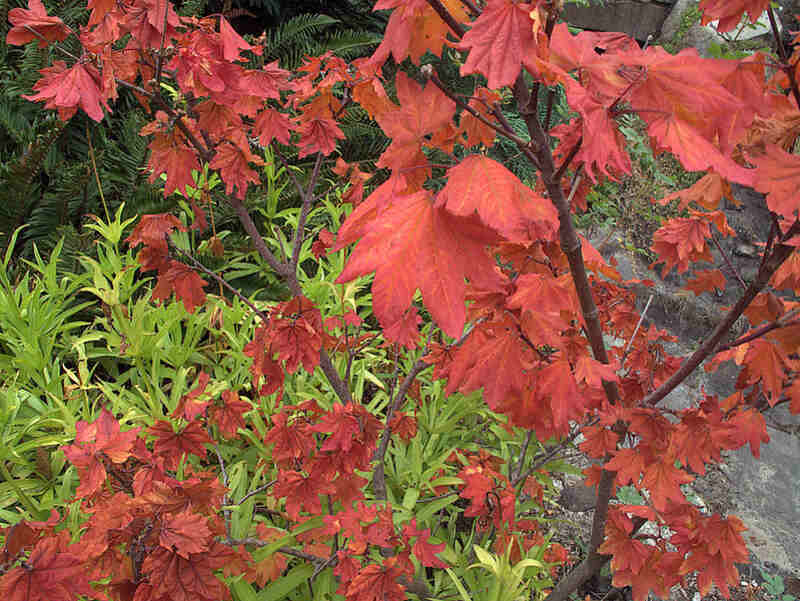
Photo Credit: John Rusk / Flickr / CC BY 2.0
Are you undecided on whether you want a bushy shrub or a small tree? Vine maple is a people-pleaser. On one hand, it can be a large spreading shrub. On the other, it sometimes develops into a moderately-sized tree. Remove branches close to the ground to promote tree-like growth.
The vine maple will even offer you a variety of colors. Its bark is reddish-green with bright green leaves. The fall ushers in orange and red-hued foliage. Small purple and white flowers arrive in the spring. The berries that soon follow draw mammals and songbirds.
Vine maple thrives in moist and cooler climates like that of Seattle. If your yard is shaded, vine maple will be a loyal companion. This shrub is a wonderful choice for a shady border or patio tree.
Plant type: Small tree, shrub
Hardiness zones: 5 to 9
Sun: Full sun to partial shade
Soil: Loam, sand, clay, moist, well-drained
Duration: Perennial
Fragrance: None
Bloom time: Spring
Water needs: Medium
Mature height: 15 to 30 feet, sometimes reaching up to 40 feet
Maintenance: Low
4. Wild Ginger (Asarum caudatum)
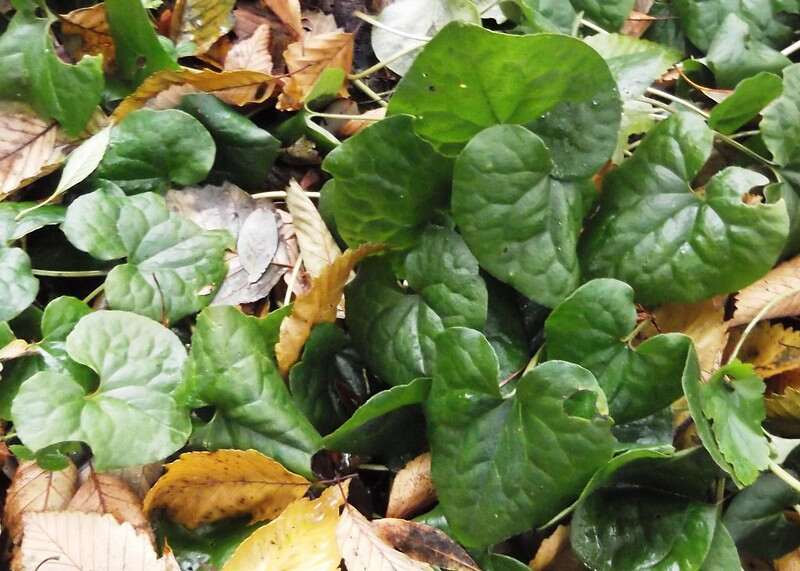
Photo Credit: brewbooks / Flickr / CC BY-SA 2.0
Wild ginger is a Seattle favorite because it thrives in wet winter conditions. It has glazed, heart-shaped leaves and deeply red-colored, three-pronged flowers that emerge around late spring and early summer. The flower’s end forms a tail. Although wild ginger smells like ginger when crushed, it’s not the spice you find on the racks at the grocery store.
Wild ginger loves shade, so it will work well on a property that doesn’t get much sun – that is, if you don’t mind a few extra creepy crawlers in your yard. Wild ginger is pollinated by ground beetles and ants. This ground cover is often used in woodland gardens and under shrubs.
Plant type: Evergreen ground cover
Hardiness zones: 4 – 8
Sun: Full or partial shade, no direct sunlight
Soil: Fertile, organic matter
Duration: Perennial
Fragrance: Leaves when crushed have a lemon-ginger smell
Bloom time: Spring
Water needs: Must stay moist
Mature height: 6-10 inches
Potential hazards: Caution is advised. Do not ingest.
Maintenance: Low
5. Salal (Gaultheria shallon)
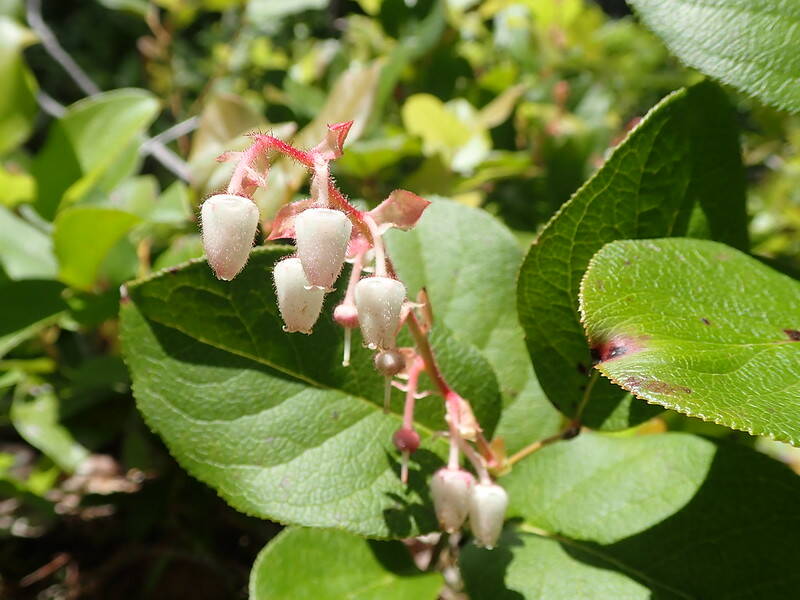
Photo Credit: Mount Rainier National Park / Flickr / CC BY 2.0
Salal is also called Shallon, and is a great choice if you love to see color in your plants in the winter. The leaves turn a red-purplish color when it’s cold. Salal is an attention-seeker, as it is high maintenance and needs pruning immediately after it flowers. But its edible and medicinal properties may make it well worth the effort.
Humans and birds can eat the deep blue berries that emerge near the end of summer. And although salal’s medicinal uses are not well known, it has been used for medicinal purposes. It has anti-cramping and anti-inflammatory properties. The leaves can be applied externally to soothe insect bites and stings. Salal has been used in jams, baked goods, and as a sweetener.
Use this attractive shrub as a ground cover or border, along slopes, or in rain gardens.
Plant type: Shrub
Hardiness zones: 5 to 9
Sun: Partial shade to full shade
Soil: Moist, acidic, well-drained
Duration: Perennial
Fragrance: Smells like wintergreen
Bloom time: Spring and summer
Water needs: Medium
Mature height: Grows up to 5 feet in shade and up to 3 feet in full sun.
Maintenance: High
6. Common Camas (Camassia quamash)
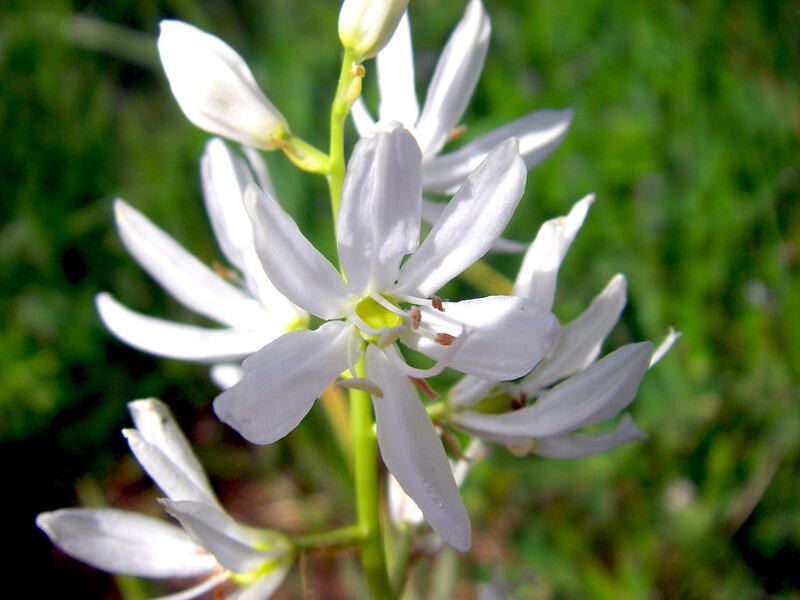
Photo Credit: Bureau of Land Management / Flickr / CC BY 2.0
Common camas is usually called by the short version of its common name, camas. The leaves are long and grass-like. Around the end of spring to the beginning of summer, sky-blue petaled flowers blossom. For best results, plant camas in the fall and give it plenty of water while it’s growing.
This wildflower attracts beetles and bumblebees, and is perfect when planted in groups in cottage gardens and borders.
Plant type: Flowering plant/wildflower
Hardiness zones: 3 to 8
Sun: Full sun, very little shade
Soil: High organic matter with good drainage; tolerates seasonally moist soil
Duration: Perennial
Fragrance: Spicy; Smells like molasses when boiled
Bloom time: Late spring to early summer
Water needs: Average /(Natively found in moist, spring meadows that dry by late spring)
Mature height: Up to 30 inches
Maintenance: Low to medium
7. Evergreen Huckleberry (Vaccinium ovatum)
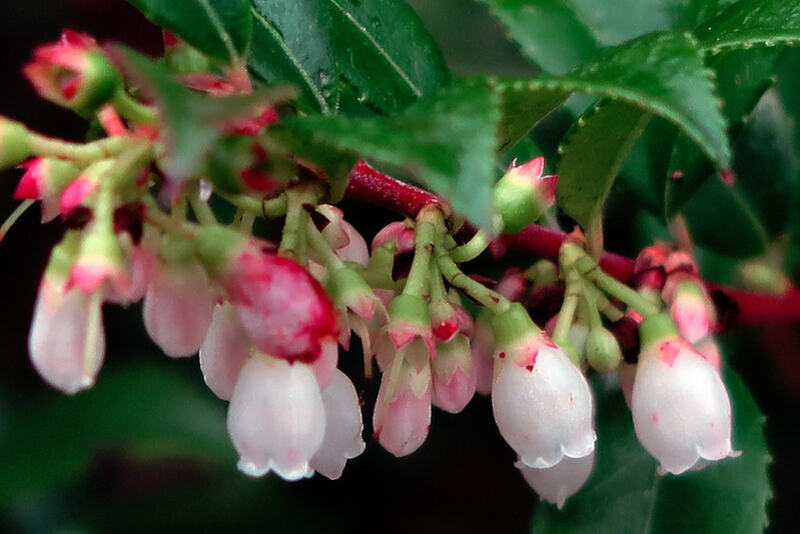
Photo Credit: John Rusk / Flickr / CC BY 2.0
Evergreen huckleberry showcases reddish leaves that emerge in the spring, and white flowers that sit underneath the leathery foliage. The blue or black colored berries come around in the late summer, bringing with them wildlife and birds that nibble on them for nourishment. One of the best things about this evergreen is that the berries serve as a buffet for humans, too. The berries have been used in pies, jellies, and syrups.
Evergreen huckleberry makes a great shrub border or hedge. It’s also a good choice for rain gardens. It’s considered high maintenance, but it may save you a trip to the grocery store.
Plant type: Needled Evergreen
Hardiness zones: 7 to 9
Sun: Sun or shade; prefers partial or full shade
Soil: Tolerates sand, clay, and soils low in organic content; requires acidic soil
Duration: Perennial
Fragrance: Musky
Bloom time: Feb to July
Water needs: Low, Medium to wet
Mature height: 2 to 10 feet tall; grows taller in shade
Maintenance: High
8. Red Flowering Currant (Ribes sanguineum)
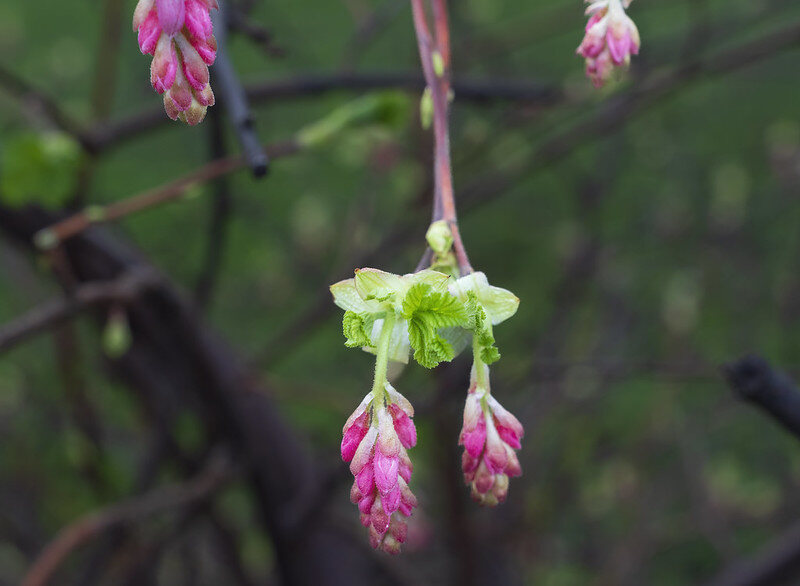
Photo Credit: John Knight / Flickr / CC BY 2.0
You may have noticed these growing alongside the Cascades. The red flowering currant is also called the blood currant. Drooping, small red-petaled flowers appear and take over the shrub in the spring.
The red flowering currant produces dark blue berries that are appreciated by humans and animals alike. The fruit has been used to make juice, pies, and jam. The red flowering currant shrub thrives well in yards with lots of sun or a little shade. This sweet, sage-rosemaryish-smelling plant attracts butterflies and hummingbirds.
Plant type: Deciduous shrub
Hardiness zones: 5 to 9
Sun: Full sun, partial shade
Soil: Prefers well-drained, rocky soil but tolerates poor soil
Duration: Perennial
Fragrance: Sweet sage-rosemary
Bloom time: Spring
Water needs: Water the first two summers of establishment
Mature height: 8 to 10 feet
Potential hazards: None known
Maintenance: Low
How to Choose Native Plants for Your Seattle Yard
All plants are not created equal. Some may look and sound attractive, but not be suitable for most homes even if they are native plants of the Pacific Northwest, like the douglas fir (Pseudotsuga menziesii). Others should not be planted close to your home because they’re highly flammable, like the eastern red cedar (Juniperus virginiana). Make sure you’re aware of the potential hazards of a plant before purchasing it.
The best plants are those that fit well with your property’s conditions, your maintenance expectations, and your family’s lifestyle. Some questions you can ask yourself are:
- Does my land provide the proper soil type?
- Can I provide the appropriate irrigation?
- Can my property accommodate plants that spread quickly or grow wide?
- Does my yard get enough sun or have enough shade?
Also, consider whether you want to spend your time pruning shrubs or if you have the budget to pay someone. If you’re too busy for high-maintenance plants, salal may be a deal breaker, while the pacific bleeding heart may be a must-have.
If you have small children or pets that may get into the vegetation, you may want to stay clear of pacific bleeding heart and indulge in a medley of red flowering currants or evergreen huckleberry.
FAQ About Native Seattle Plants
What are some Seattle native plants that are toxic to dogs and cats?
If you have pets, you may have concerns about plants that will make them sick. According to the Washington Native Plant Society, the American Society for the Prevention of Cruelty to Animals (APSCA) lists several plants that can be harmful to pets. Here are five native plants harmful to dogs and cats that are most commonly found in the Seattle area:
- Dogbane (Apocynum spp.)
- Cow parsnip (Heracleum maximum)
- Redwood sorrel (Oxalis oregana)
- Chokecherry (Prunus virginiana)
- Pacific yew (Taxus brevifolia)
What plants are native to Washington State?
Many plants are native to Washington, including:
- Red Flowering Currant
- Pacific Bleeding Heart
- Common Camas
- Red-osier Dogwood
- Tall Oregon Grape
- Vine Maple
- Salal
- Evergreen Huckleberry
- Serviceberry
- Indian Plum
What is a USDA hardiness zone?
USDA hardiness zones identify which plants grow best in which areas of North America. The U.S. Department of Agriculture divides zones by average lowest winter temperatures. Knowing your area’s hardiness zone helps you identify the right plants that will thrive in Seattle.
King County is a bit confusing, as it’s in two zones. Most of the county is in zone 8. The eastern part of the county is in zone 7. If you don’t know which zone you’re in, ask your local nursery.
What are some advantages of native plants?
Using native plants can make your life easier. These plants already thrive in their current environment, so they take less maintenance. This saves resources and money.
Native plants need less water and require fewer pesticides and fertilizers if any. This means fewer hazardous chemicals running off into creeks and other water-supply sources.
By choosing Seattle native plants, you can enjoy bonding with nature as you see a beautiful display of various insects, butterflies, and native wildlife flocking to a diverse buffet of vegetation.
Where to Find Native Plants in Seattle
If you’ve been to Carkeek Park, you’ve seen some native plants. You’ve probably also seen plenty of native plants while you were out walking in your neighborhood or driving around the city. Adding native plants to your home will create a colorful and diverse environment that gives back to the ecosystem. The Washington Native Plant Society highlights community events and sites where you can see native vegetation and take advantage of plant sales.
Check out these local nurseries in the Seattle area recommended by the King Conservation District:
Soaking in the sunshine and fresh air by spending time working in the garden or around the yard can be calming. But everyone deserves a break. When you’re ready to let someone else do the work, call your lawn care professional.
Main Image Credit: Oregon Grape / Kirt Edblom / Wikimedia Commons / CC BY-SA 2.0